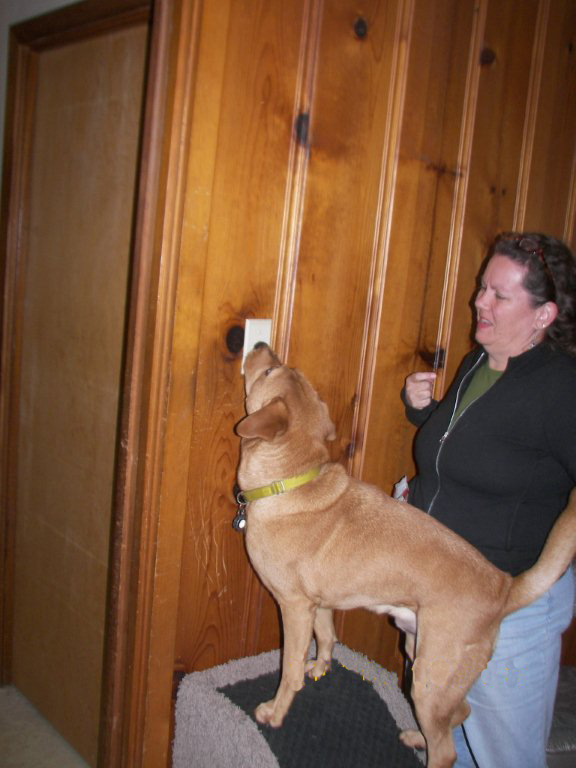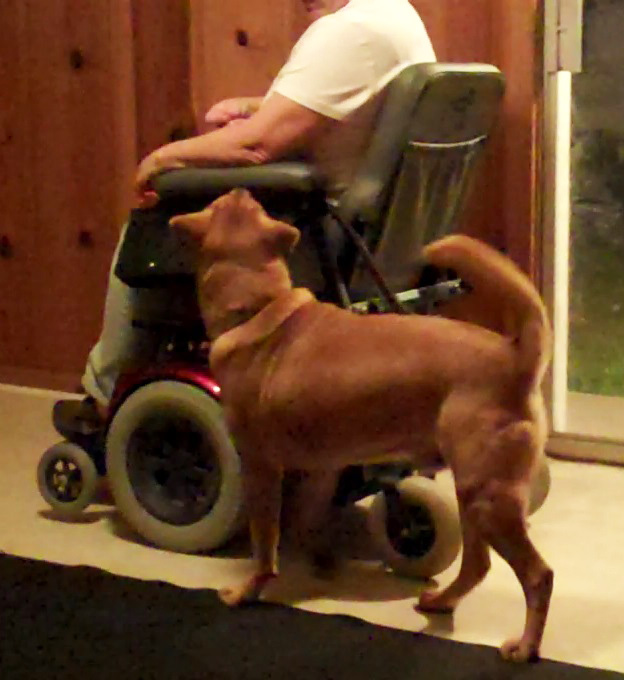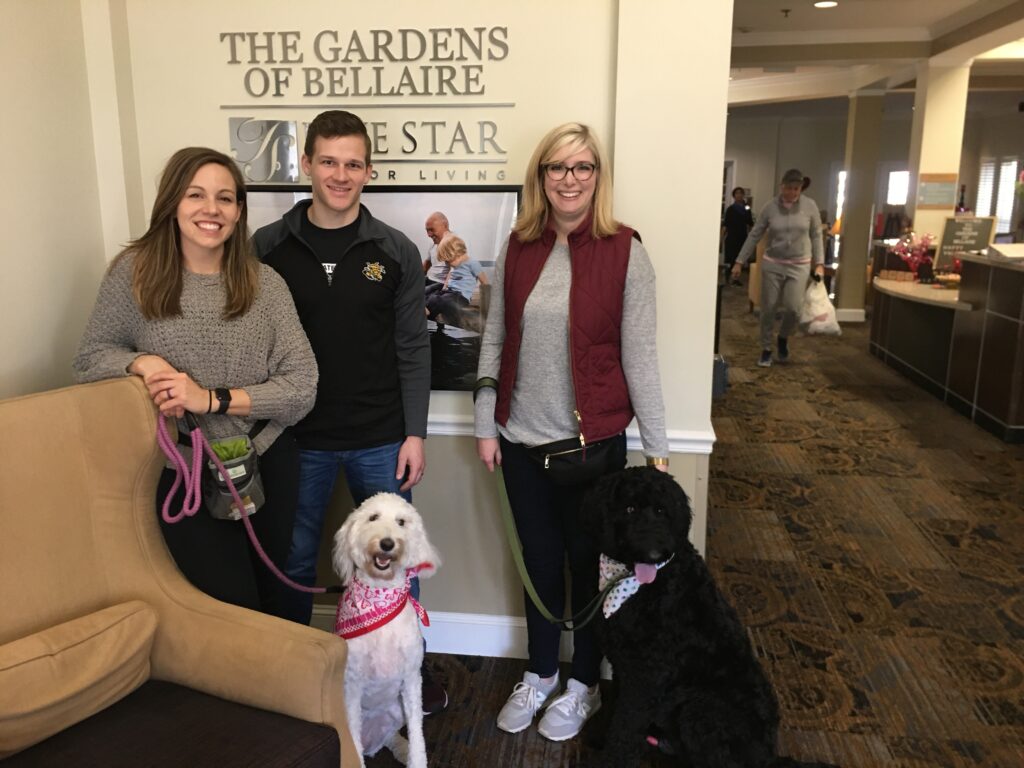

Training Your Own Service Dog
Thinking of training your own service dog? Contact us with some basic information about your training needs. First, we’ll talk about what’s involved in selecting a dog and training him or her for service dog work. Your current dog may be suitable for service dog work, but this is not typical. Before we begin, we will carefully evaluate your dog. It’s important to make sure training your dog to meet your needs will be efficient and therefore economical. Second, we’ll talk about your abilities and willingness to follow a training plan and instructions for developing your training skills. You are your service dog’s best trainer and with my coaching, you can succeed; however, it takes commitment.
Service dogs are required to be safe and reliable in public, and to be trained in at least one task that mitigates your disability. We maintain high standards and help our clients achieve them. It takes time, even though we use efficient and effective positive reinforcement techniques. Plan on a minimum of one year of continual training. Plan for a minimum of $5000. Know that we will do our best to make training economical although we can’t cut corners on training.
We do our best to provide training in ways that are both effective and as economical as possible. One technique we often use is to start our Service Dog clients out with our Beyond Basic Manners Class. They advance to a group Service Dog class or a private dog training package to learn their public access and task skills. Your training plan will depend on the tasks you need your service dog to do for you, your own training abilities, and the time and commitment you invest in training.
What is a Service Dog?
“Service Dog” and “Assistance Dog” mean the same thing. They are not pets. Technically, they are living pieces of medical equipment that help mitigate the effects of disabilities on their human partners. (Service dogs have the same needs as all dogs because they are living, breathing beings!) People with Disabilities (PWDs) have the legal right to public access with properly trained and qualified Service Dogs. Service Dogs have no rights whatsoever; People with Disabilities have the rights by law.
Who can use a Service Dog?
To legally use a Service Dog, you must be a person with a disability (PWD.) For a dog to be a Service Dog, he must be trained to perform a specific task related to your disability, safely and reliably in public areas. For a PWD to have the right to take a Service Dog into public places, the dog must be trained to certain minimum standards to ensure the safety of the PWD, the dog, and the public as well.
A Service Dog can help a person with disabilities to
- Be more independent
- Feel more confident
- Complete daily tasks with ease
Tasks Service Dogs can do to help their human partners include:
- Retrieving dropped objects
- Opening and closing doors, cabinets, and refrigerators
- Helping with sock and jacket removal
- Turning light switches on and off
- Providing tactile stimuli to alert partner to anxiety or medical issues
No Certification is Legally Required
No certification will give you the legal right to use a service dog. Please do not enable the internet pirates to continue taking people’s money by lying about certifications. Only a disability and sufficient dog training allow you to legally use a service dog. A trainer may “certify” you and your service dog as a team, but that’s not a legal requirement. Trainers “certify” to protect their reputations. They document that they’ve trained the team, and they may require annual re-certification. This ensures the team maintains their training so the dog reliably and safely does his work for you.
Therapy Dogs

Therapy Dogs are dogs used in visits to hospitals, nursing homes, schools, and other places. They help their human partners educate, motivate, and lift the spirits of patients and students. These dogs must be carefully selected and well-trained for their jobs. Handlers have no legal access rights for their therapy dogs; they must be invited into facilities where their services are welcome. These handlers delight in sharing their Mannerly Dogs with others. We train therapy dogs and handlers to high standards so they are helpful to others and welcome wherever they go.
Training Your Therapy Dog
We most often start training therapy dogs in our Beyond Basic Manners Class. They move on to an advanced group training class or to a private dog training package. We would love to build a therapy dog team again!
Terminology
What is a Guide Dog or Seeing Eye Dog?
Guide Dogs, Seeing Eye Dogs are Service dogs that assist visually impaired people. (These terms are copyrighted for the organizations that train these dogs, but have become rather colloquial in their use.)
What is a Mobility Service Dog?
Mobility Service or Assistance Dogs are Service dogs that assist people using wheelchairs or walkers, or people with other, often invisible disabilities like MS, Epilepsy, and many others.
What is a Hearing Dog?
Hearing Dogs are Service dogs that assist people with hearing impairment.
What is a Psychiatric Service Dog?
Psychiatric Service Dogs are Service dogs that assist people with psychiatric Disabilities like Panic Disorder, PTSD, anxiety, depression and others. These dogs must be trained to perform a task to help the person with the disability. They may also provide emotional support and companionship. However, emotional support is not enough by itself to transform a pet dog into a Service Dog.
What is a Therapy Dog?
Therapy Dogs are very different from Service Dogs. They have no legal definition and their handlers have no legal privileges to bring their dogs with them into businesses. These trained teams are invited into facilities to educate, motivate, and lift the spirits of patients and students. They must be safe and reliable, much like Service Dogs, but they have no requirements for specific tasks. The Mannerly Dog trains therapy dogs and their handlers to high standards; they are helpful to others and welcome wherever they go. We encourage training therapy dogs to do tricks and fun behaviors to delight their patrons, though it’s not required.
What is an Emotional Support Animal (ESA)?
Legal rights for people partnering with ESAs are limited to housing allowances and some airline privileges, although those are changing rapidly because of incidents involving poorly trained animals. ESAs are well-trained pets. Their owners are confident in taking their dogs to places where they have permission to bring them. We like for all pet dogs to be mannerly and able to accompany their owners to dog-friendly places! Start training your dog to be your ESA in our Beyond Basic Manners Class.
Where to get further information
IAADP (International Association of Assistance Dog Partners) is a non-profit, cross-disability organization representing people partnered with guide, hearing and service dogs. One of their primary goals is to educate and provide information on service dogs to those who need it. You can access the information on their website here: www.iaadp.org.
Assistance Dogs International (ADI) is another good resource for service dog information. Click here for their website.

